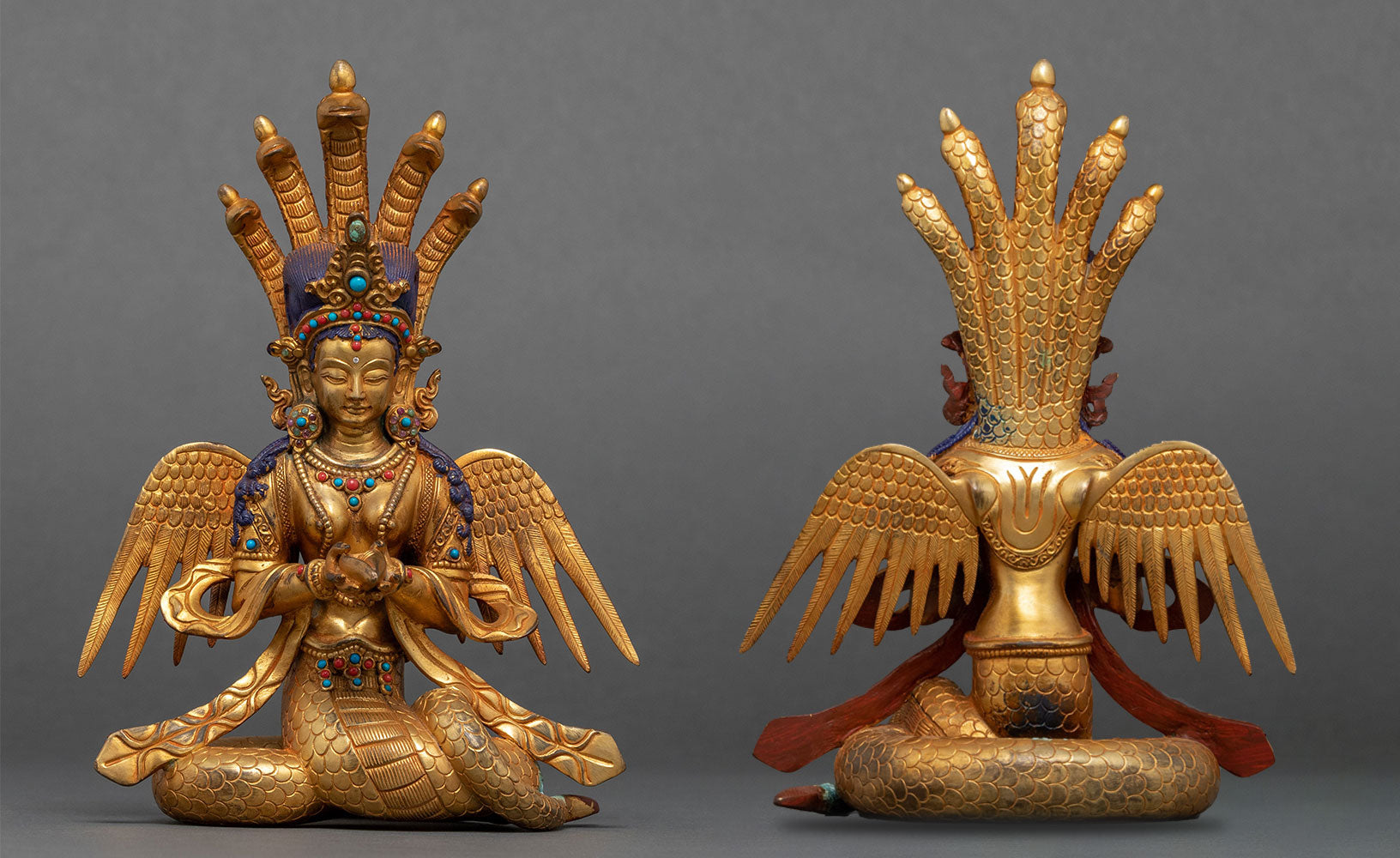Naga Kanya Goddess in Buddhist Art: Serpent Symbolism Explored
The Naga Kanya Goddess (Naag Kanya), a prominent figure in Hindu and Buddhist mythology, encapsulates the enigmatic and potent energies of serpents intertwined with the divine feminine. Often depicted as a woman with a serpent's lower body, she symbolizes wisdom, fertility, and the mystical bridge between earthly and celestial realms.
Key Highlights:
- Naga Kanya holds a central role in both Hindu and Buddhist traditions.
- Her symbolism encompasses wisdom, protection, fertility, and a connection with nature.
- She is renowned for her association with water elements and is frequently portrayed with multiple snake heads.
Naag Kanya, a revered divine entity in Eastern traditions, links gods and humans. Her depiction as a half-woman, half-serpent symbolizes the profound unity of opposites – the spiritual and the material. As a guardian of treasures and a symbol of fertility, Naga Kanya's imagery carries rich cultural and spiritual significance.
Naga Kanya Mythology

Click here to view our Naga Kanya Statue
Early References: The earliest mentions of Naga Kanya surface in ancient Vedic texts, portraying her as a benevolent guardian deity. These scriptures associate her with water bodies and subterranean realms, embodying themes of abundance and fertility.
Legends and Lore
Numerous Hindu and Buddhist mythology legends recount tales of Naga Kanya. One prevalent legend describes her emergence from the churning milky ocean, symbolizing her integral role in cosmic balance. Another narrative highlights her intervention in saving a village from drought, showcasing her as a protector and nurturer.
Cultural and Religious Practices
Worship and Rituals: Naga Kanya receives worship through various rituals in diverse cultures. Temples dedicated to Naga deities in India and Nepal often feature representations of Naga Kanya. Rituals involving offerings and prayers seek her blessings for fertility and protection.
Festivals and Celebrations
Certain festivals, particularly in South and Southeast Asia, are dedicated to serpent deities, including Naga Kanya. These festivities, marked by rituals, dances, and offerings, celebrate her divine qualities and reinforce her cultural significance.
Iconography of Naga Kanya Goddess
The Naga Kanya Goddess, a captivating figure in Eastern mythology, uniquely blends serpentine and feminine qualities. Her rich iconography, filled with symbolism and cultural significance, portrays her as a divine entity bridging the human and mystical realms. Let's explore the detailed physical attributes and iconography of the Naga Kanya Goddess:
Physical Attributes:
- Human-Serpent Hybrid Form: Portrayed as a beautiful woman from the waist up and a serpent from the waist down, symbolizing the integration of earthly and spiritual realms.
- Multiple Cobra Heads: Often depicted with multiple cobra heads behind her human head, each representing a layer of consciousness or a realm of existence, showcasing her dominion over various dimensions.
- Ornate Jewelry and Garments: Adorned with intricate jewelry, symbolizing her divine status, and depicted in flowing, elegant garments for an ethereal and majestic presence.
- Lotus Symbolism: Frequently shown seated or standing on a lotus, symbolizing purity, spiritual awakening, and the unfolding of divine potential.
Detailed Iconography:
- Serpentine Lower Body: The serpent part symbolizes rebirth, healing, and transformation, reflecting primal energy and the earth's connection.
- Third Eye: Some depictions feature a third eye on her forehead, symbolizing spiritual insight and wisdom, aligning her with deities in Hindu and Buddhist traditions.
- Color Symbolism: Colors in depictions hold significance - green for nature and life, blue for water and the celestial realm, and gold/red for royalty, divinity, and vitality.
- Water and Nature Elements: Linked with water elements, lakes, rivers, and the underworld, emphasizing her connection with nature and role as a protector of natural treasures.
- Protective Posture: Graceful yet powerful stance, especially with cobra hoods spread wide, signifying her role as a guardian and protector.
- Facial Expression: Varies from serene and benevolent to fierce and protective, reflecting her benevolence, wisdom, and protective nature based on the narrative.
- Hand Gestures (Mudras): Specific mudras hold symbolic meanings - blessing symbolizes her role as a benefactor and protector, while gestures of teaching align her with spiritual wisdom.
Significance in Buddhism & Hinduism

The Naga Kanya Goddess holds significant importance in Hinduism and Buddhism, with each tradition interpreting her attributes in distinctive yet interconnected ways. Her symbolism, deeply rooted in ancient lore, has evolved, mirroring these major Eastern religions' spiritual and cultural nuances.
Naga Kanya Hindu Goddess
In Hindu mythology, the Naga Kanya Goddess is intricately woven into the religion's mythological narratives and spiritual symbolism.
- Guardian of Treasures and Knowledge: Revered as a guardian of immense treasures and profound knowledge, symbolizing not only material wealth but also spiritual abundance and wisdom.
- Association with Deities: Frequently linked with powerful deities like Lord Shiva and Lord Vishnu, sometimes portrayed as devotees or attendants, highlighting her divine status and role in the celestial hierarchy.
- Symbol of Fertility and Nature: The serpentine aspect associates her with fertility and the earth, making her a figure worshipped for blessings related to fertility and bountiful harvests, embodying the nurturing element of nature.
- Protector and Healer: Believed to possess the ability to avert disasters and cure ailments, particularly those involving poisons, connecting her to the ancient practices of Ayurveda and traditional Hindu medicine.
- Connection with Astrological Beliefs: In Vedic astrology, serpents, and by extension, Naga Kanya, are deemed significant, influencing planetary alignments and life events, making her integral to astrological consultations and rituals.
Naga Kanya Buddhism
In Buddhism, notably within Tibetan and Mahayana traditions, Naga Kanya plays a distinct role, emphasizing her guardianship of the Dharma and support for the spiritual journey of practitioners.
- Protector of the Dharma: Regarded as a guardian of the teachings of the Buddha, safeguarding them from corruption or loss.
- Symbol of Transformation and Enlightenment: Her half-human, half-serpent form symbolizes the potential for transformation and enlightenment, representing the journey from the mundane to the sublime, from ignorance to wisdom.
- Connection with Rain and Harvests: Associated with the control of elements, especially rain, she is revered for favorable weather and abundant harvests in agrarian Buddhist societies.
- Role in Rituals and Festivals: Prominently featured in Buddhist rituals and festivals, where prayers and offerings seek to appease Naga spirits for blessings related to fertility, prosperity, and protection from natural calamities.
- Link to Tantric Practices: In Tibetan Buddhism, Naga Kanya is occasionally associated with tantric practices; her imagery is used in esoteric rituals to harness spiritual energies and attain higher states of consciousness.
In both Hinduism and Buddhism, the Nagakanya Goddess transcends being a mere mythological figure. She encompasses many attributes - guardian, protector, healer, symbol of fertility and transformation - embodying versatility and enduring reverence in these religions. Her veneration underscores the profound connection these traditions maintain with nature, the spiritual realm, and the pursuit of wisdom and enlightenment.
The enduring legacy of the Naag Kanya Goddess underscores her profound importance in the spiritual and cultural fabric across ages. Serving as a symbol of wisdom, protection, and the mysterious connection between realms, she continues to captivate and inspire.















